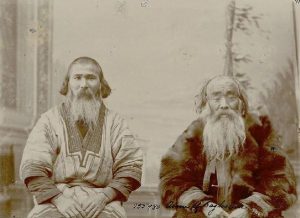
Being a very vast country, Russia becomes the home to so many different ethnic groups. Some of them look very much like European, some are closer to Asian. If you take a look at the map and learn the history of Russia, you will understand why. Among so many ethnic groups, there is one called Ainu – which you might probably found more familiarly tied with the Japanese. Now you should know that some of the Ainu groups do live in the Russian region. Here is the brief story about it.
The Origin of Ainu
The origin of the Ainu is currently unclear. Europeans, faced with the Ainu in the 17th century, were struck by their appearance. Unlike the usual kind of people of the Mongoloid race with swarthy skin, a Mongolian fold of the eyelid, sparse facial hair, Ainu possessed unusually thick hair covering their heads, wore huge beards and mustaches with australoid facial features which some of the signs were similar to European.
There are many hypotheses about the origin of Ainu, which in general can be divided into three groups:
- Ainu are related to the Caucasians (Caucasian race) – this theory adhered to J. Bachelor, S. Murayama.
- Ainu are related to the Austronesians and came to the Japanese islands from the south – L. Ya. Sternberg put forward this theory and it dominated Soviet ethnography.
- The Ainu are related to the Paleo-Asian peoples and came to the Japanese islands from the north / from Siberia – this is mainly the opinion of Japanese anthropologists.
Ainu in Russia
Russian Ainu can be divided into six groups, of which three are completely extinct:
1. Kamchatka Ainu; which in Russian texts are found as Kamchatka Kuril Islands. They ceased to exist as a separate people. Some representatives were assimilated by the Kuril peoples and Kamchadals. The last time was noticed by Russian researchers in the 18th century.
2. North Kuril Ainu. Until 1875, they existed under Russian control. For the first time came under the control of the Japanese after the St. Petersburg Treaty. Mostly lived on the island of Shumshu and partially on Paramushir. The total number in 1860 was 221 people. They had Russian names, they spoke fluent Russian and were Orthodox. When the islands were given to Japan, more than a hundred Ainu fled to Kamchatka and were assimilated by the Kamchadals. Those who remained under Japanese rule in 1884 were forcibly transported to Shikotan, where, being deprived of their usual habitat, they began to die in mass from diseases. After World War II, they completely disappeared. About 100 people currently live in the Ust-Bolsheretsky district.
3. South Kuril Ainu. Until the 18th century, there were almost 2,000 people, mainly in Kunashir, Iturup and Urup. In 1884, their number dropped to 500. About 50 individual representatives who remained on the islands by 1941 were evacuated to Hokkaido by the Japanese shortly after World War II. The last Japanese representative of the tribe, Tanaka Kinu, died in Hokkaido in 1973. Only 6 people survived in Russia (all from the Nakamura family).
4. Amur Ainu; individual representatives who married ethnic Russian and ethnic ulchans. Marked by Bronislaw Pilsudski at the beginning of the 20th century. During the 1926 census, only 26 purebred representatives were registered in the Nikolaev district (now the Nikolaev district of the Khabarovsk Territory). Most likely, they were assimilated by the Russians. Despite the fact that no one in the Khabarovsk Territory currently calls themselves Ainu , there live a large number of Ulches of partially Ainu origin.
5. Severosakhalinsky Ainu; only five thoroughbred representatives were registered during the 1926 census. Most Sakhalin Ainu (mainly from the coast) were relocated to Hokkaido in 1875 by the Japanese. Several people (mainly in remote areas) married ethnic Russians, judging by the records of Bronislaw Pilsudski. This tribe has become extinct, although you can still find individual inhabitants with Ainu roots.
6. South Sakhalin Ainu; after World War II, Japan evacuated almost all of the Ainu to Hokkaido. Some isolated representatives remained on Sakhalin. In 1949, there were about 100 Ainu living on Soviet Sakhalin. The last three purebred representatives died in the 1980s. Now there are only representatives of mixed origin (Russian-Ainu, the Japanese-Ainu and Nivkh-Ainu). There are several hundreds of them, but only few of them consider themselves Ainu.
Are Ainu people actually Russian?
The Kamchatka Ainu first came into contact with Russian merchants at the end of the 17th century. Relations with the Amur and North Kuril Ainu were established in the 18th century. The Ainu were considered Russian, distinguished by their race from their Japanese relations. By the middle of the 18th century, more than one and a half thousand Ainu accepted Russian citizenship. Even the Japanese could not distinguish Ainu from Russians because of their external similarities (white skin and australoid facial features, which in some ways are similar to Caucasoid ones). When the Japanese first made contact with the Russians, they named them Red Ainu or Ainu with blond hair. Only at the beginning of the 19th century did the Japanese understand that the Russians and the Ainu are two different peoples. However, for Russians, Ainu were “hairy,” “dark-skinned,” “dark-eyed,” and “dark-haired.” The first Russian scholars described Ainu like Russian peasants with dark skin or more like gypsies.
Ainu were on the side of the Russians during the Russo-Japanese wars of the 19th century. However, after the defeat in the Russo-Japanese War of 1905, the Russians left them to their fate. Hundreds of Ainu were destroyed and their families were forcibly transported to Hokkaido by the Japanese. As a result, the Russians failed to win the Ainu during World War II. Only a few Ainu representatives decided to stay in Russia after the war. Over 90% went to Japan.
